Related Research Articles
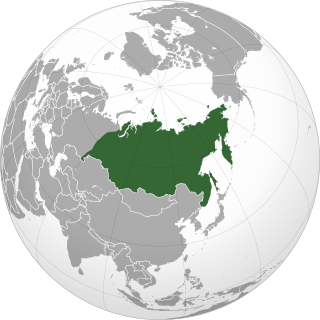
Siberia is an extensive geographical region comprising all of North Asia, from the Ural Mountains in the west to the Pacific Ocean in the east. It has formed a part of the sovereign territory of Russia and its predecessor states since the centuries-long conquest of Siberia, which began with the fall of the Khanate of Sibir in the late 16th century and concluded with the annexation of Chukotka in 1778. Siberia is vast and sparsely populated, covering an area of over 13.1 million square kilometres (5,100,000 sq mi), but home to roughly a quarter of Russia's population. Novosibirsk, Krasnoyarsk, and Omsk are the largest cities in the area.

The Baikal–Amur Mainline is a 1,520 mm broad-gauge railway line in Russia. Traversing Eastern Siberia and the Russian Far East, the 4,324 km (2,687 mi)-long BAM runs about 610 to 770 km north of and parallel to the Trans-Siberian Railway.
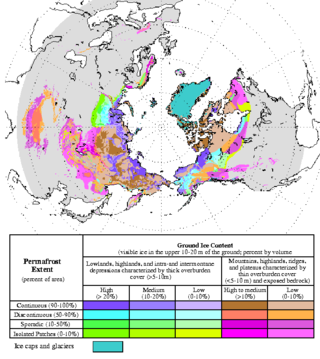
Permafrost is soil or underwater sediment which continuously remains below 0 °C (32 °F) for two years or more: the oldest permafrost had been continuously frozen for around 700,000 years. Whilst the shallowest permafrost has a vertical extent of below a meter (3 ft), the deepest is greater than 1,500 m (4,900 ft). Similarly, the area of individual permafrost zones may be limited to narrow mountain summits or extend across vast Arctic regions. The ground beneath glaciers and ice sheets is not usually defined as permafrost, so on land, permafrost is generally located beneath a so-called active layer of soil which freezes and thaws depending on the season.
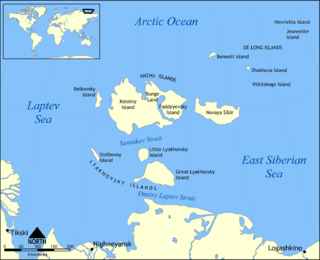
The New Siberian Islands are an archipelago in the Extreme North of Russia, to the north of the East Siberian coast between the Laptev Sea and the East Siberian Sea north of the Sakha (Yakutia) Republic, of which they are administratively a part.

Bolshoy Lyakhovsky Island, or Great Lyakhovsky, is the largest of the Lyakhovsky Islands belonging to the New Siberian Islands archipelago between the Laptev Sea and the East Siberian Sea in northern Russia. It has an area of 5,156.6 km2 (1,991.0 sq mi), and a maximum altitude of 311 m (1,020 ft).

The subarctic zone is a region in the Northern Hemisphere immediately south of the true Arctic, north of humid continental regions and covering much of Alaska, Canada, Iceland, the north of Fennoscandia, Northwestern Russia, Siberia, and the Cairngorms. Generally, subarctic regions fall between 50°N and 70°N latitude, depending on local climates. Precipitation is usually low, and vegetation is characteristic of the taiga.

Urban Dead is a free-to-play HTML/text-based massively multiplayer online role-playing game created by British developer Kevan Davis. Set in a quarantined region of the fictional city of Malton, it deals with the aftermath of a zombie outbreak. Players enter the game either as a survivor or a zombie, each with different abilities and limitations. Survivors become zombies when they are killed, while zombies can be "revivified" with appropriate technology, returning to life as a survivor – any character played for long will thus spend some time alive and some as a zombie. There are no non-player characters in the game: all survivors and zombies are controlled by players.

Day of the Dead 2: Contagium is a 2005 horror film written by Ana Clavell and directed by Clavell and James Dudelson, starring Justin Ipock, Laurie Maria Baranyay and John F. Henry III. It was unofficially marketed as a prequel and sequel to 1985's Day of the Dead. The film was released direct-to-video in the United States on October 18, 2005.

Arctic methane release is the release of methane from Arctic ocean floors, lake bottoms, wetlands and soils in permafrost regions of the Arctic. While it is a long-term natural process, methane release is exacerbated by global warming. This results in a positive climate change feedback, as methane is a powerful greenhouse gas. The Arctic region is one of many natural sources of methane. Climate change could accelerate methane release in the Arctic, due to the release of methane from existing stores, and from methanogenesis in rotting biomass. When permafrost thaws as a consequence of warming, large amounts of organic material can become available for methanogenesis and may ultimately be released as methane.

Marvel Zombies is a comic book metaseries published by Marvel Comics. The series features zombie versions of Marvel Universe superheroes and supervillains who have been portrayed as both protagonists and antagonists through the different limited series within the metaseries.
Johan Hultin was a Swedish-born American pathologist known for recovering tissues containing traces of the 1918 influenza virus that killed millions worldwide.
Resident Evil is a biopunk action horror film series based on the Japanese video game franchise by Capcom.

Silene stenophylla is a species of flowering plant in the family Caryophyllaceae. Commonly called narrow-leafed campion, it is a species in the genus Silene. It grows in the Arctic tundra of far eastern Siberia and the mountains of northern Japan. Frozen samples, estimated via radiocarbon dating to be around 32,000 years old, were discovered in the same area as current living specimens, and in 2012, a team of scientists successfully regenerated a plant from the samples.

Pandoravirus is a proposed genus of giant virus, first discovered in 2013. It is the third largest in physical size of any known viral genus, behind Pithovirus and Megaklothovirus. Pandoraviruses have double stranded DNA genomes, with the largest genome size of any known viral genus.

Pandoraviridae is a proposed family of double-stranded DNA viruses that infect amoebae. There is only one genus in this family: Pandoravirus. Several species in this genus have been described, including Pandoravirus dulcis, Pandoravirus salinus and Pandoravirus yedoma.
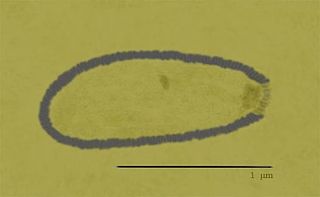
Alphapithovirus, first described in a 2014 paper, is a genus of giant virus known from two species, Alphapithovirus sibericum, which infects amoebas and Alphapithovirus massiliense. It is a DNA based virus and is a member of the nucleocytoplasmic large DNA viruses clade. The 2014 discovery was made when a viable specimen was found in a 30,000-year-old ice core harvested from permafrost in Siberia, Russia.
Mollivirus sibericum is a giant virus discovered in 2015 by French researchers Chantal Abergel and Jean-Michel Claverie in a 30,000-year-old sample of Siberian permafrost, where the team had previously found the unrelated giant virus Alphapithovirus sibericum. Mollivirus sibericum is a spherical DNA virus with a diameter of 500–600 nanometers (0.5–0.6 μm).
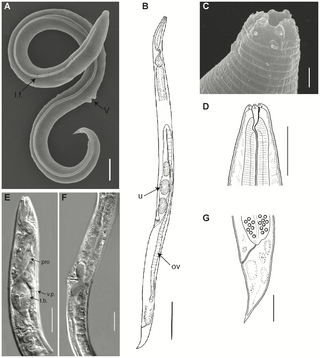
Panagrolaimus kolymaensis is a species of nematode.

On Earth, frozen environments such as permafrost and glaciers are known for their ability to preserve items, as they are too cold for ordinary decomposition to take place. This makes them a valuable source of archeological artefacts and prehistoric fossils, yet it also means that there are certain risks once ancient organic matter is finally subject to thaw. The best-studied risk is that of decomposition of such organic matter releasing a substantial quantity of carbon dioxide and methane, and thus acting as a notable climate change feedback. Yet, some scientists have also raised concerns about the possibility that some metabolically dormant bacteria and protists, as well as always metabolically inactive viruses, may both survive the thaw and either threaten humans directly, or affect some of the animal or plant species important for human wellbeing.